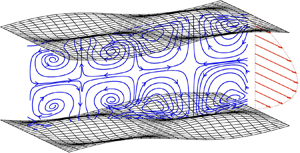Article contents
Langmuir-type vortices in wall-bounded flows driven by a criss-cross wavy wall topography
Published online by Cambridge University Press: 07 August 2020
Abstract

We investigate a mechanism to manipulate wall-bounded flows whereby wave-like undulations of the wall topography drives the creation of bespoke longitudinal vortices. A resonant interaction between the ambient vorticity of the undisturbed shear flow and the undulation of streamlines enforced by the wall topography serves to slightly rotate the spanwise vorticity of the mean flow into the streamwise direction, creating a swirling motion, in the form of regular streamwise rolls. The process is kinematic and essentially identical to the ‘direct drive’ CL1 mechanism for Langmuir circulation (LC) proposed by Craik (J. Fluid Mech., vol. 41, issue 4, 1970, pp. 801–821). Wall shear is modelled by selecting suitable primary flow profiles. A simple, easily integrable expression for the cross-plane streamfunction is found in two asymptotic regimes: the resonant onset of the essentially inviscid instability at early times, and the fully developed steady-state viscous flow. Linear-order solutions for flow over undulating boundaries are obtained, fully analytical in the special case of a power-law profile. These solutions allow us to quickly map out the circulation response to boundary design parameters. The study is supplemented with direct numerical simulations which verify the manifestation of boundary induced Langmuir vortices in laminar flows with no-slip boundaries. Simulations show good qualitative agreement with theory. Quantitatively, the comparisons rest on a displacement length closure parameter adopted in the perturbation theory. While wall-driven LC appear to become unstable in turbulent flows, we propose that the mechanism can promote swirling motion in boundary layers, a flow feature which has been reported to reduce drag in some situations.
JFM classification
- Type
- JFM Papers
- Information
- Copyright
- © The Author(s), 2020. Published by Cambridge University Press
References
REFERENCES
- 2
- Cited by




